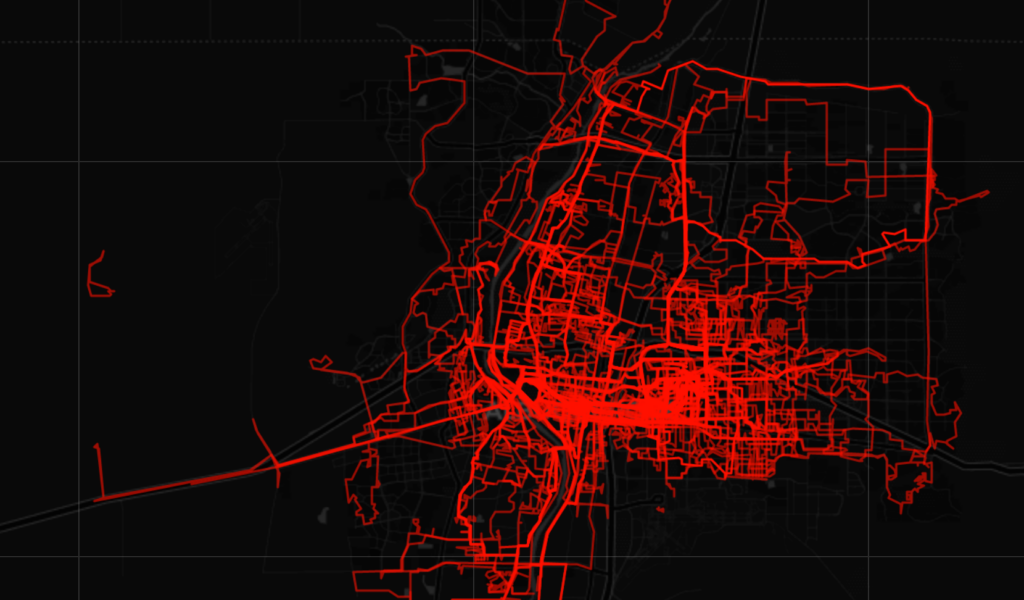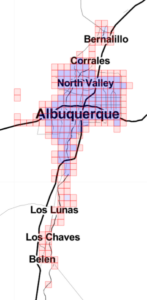
my 2021 rides in the heart of Albuquerque
In September 2019, my friend Scot and I did one of our more memorable “what happens if we turn here” bicycle rides.
In our endless search for what I call “longcuts” – the safest route, rather than the shortest – we followed a concrete flood control channel called the North Pino Arroyo up through Albuquerque’s far northeast heights.
As long as it’s not raining, it’s a super safe route, because no cars!
It also came with fascinating side effect. Below grade, lined with neighborhood back fences, the ride deprived us of our usual geographical cues – as close to being “lost” as is possible in a city with a mountain looming to the east and a river to the west.
We emerged in a park at the arroyo’s uphill terminus, with a general sense of where we were, but only the vaguest of ideas as to the specifics. We have a “no iPhone maps” rule on our rides, so the only way to get our bearings was to keep riding.
It was delightful.
“To become completely lost,” Kevin Lynch wrote in his 1960 book The Image of the City, “is perhaps a rather rare experience for most people in the modern city.”
I ride a lot, and I map all my rides. I’ve done that for years, since the first affordable, portable bike-mounted GPS gizmos became available. I used to ride a bunch of favorite roads and trails over and over, but in recent years, I’ve used the technology and a couple of cool web tools to think about where I haven’t ridden yet.
Map Games

2021 Albuquerque tiles ridden
One game, which goes by the name “tiling”, divides the world up into mappable tiles – think an entire globe covered with bingo squares. It’s based on Ben Lowe’s Veloviewer, one of a number of great indy web-based software platforms for this kind of stuff. (See Ride Every Tile for a window into the strange and wonderful world of tiling – my obsession is modest compared with some of the European tilers.)
The other game, which I began playing this year, uses Craig Durkin’s Wandrer. Wandrer ingests all your old GPS rides and gives you a map of roads you haven’t ridden. You can even download a map onto your bike GPS gizmo to see streets around you as you’re out riding.
This leads to a lot of cul-de-sacs and resulting dog-related adventures.
I’ve always been a bit wandery in my riding, and Veloviewer and Wandrer provide a fascinating structure around the thing. I’ll often plan a ride with a vague goal of an unridden tile and a map of unridden roads in the area. But I rarely end up doing what I intended. And why not? It’s a bike ride!
This year I’ve ridden:
- 311 Veloviewer tiles, 103 Veloviewer that I’d never before visited
- 5,044 miles, 572 on roads and trails I’d never before ridden
Why I ride
When I finally settled on setting the next book here in my “Middle Valley” rather than on the Lower Colorado River, one of the reasons on the “plus” side of the ledger was the ability to hop on my bike and ride to my “field area”. All this bike riding, what my friend Maria Lane labeled #geographybybike, involves the construction of intuitive maps of the landscape, hydrographic and human. The time from side yard bike shed to Rio Grande is 35 minutes – less if I need it.
Picking up new Veloviewer tiles and Wandrer miles creates a bit of a framework for expanding that mental map.
That’s true and all, but also maybe just a layer of excuse?
The neuroscientist and urbanist Robin Mazumder wrote a piece in 2019 that really captures why I ride. It’s about what psychologists call “flow”:
According to Jeanne Nakamura and Mihaly Csikszentmihalyi, flow involves the following elements:
- Merging of action and awareness
- Intense and focused concentration on what one is doing in the present moment
- Loss of reflective self-consciousness
- A sense that one can control one’s actions; that is, a sense that one can in principle deal with the situation because one knows how to respond to whatever happens next
- Distortion of temporal experience (typically, a sense that time has passed faster than normal)
- Experience of the activity as intrinsically rewarding, such that often the end goal is just an excuse for the process.
It’s not uncommon for me to return from a ride and have Lissa say, “You were gone a long time!” And I know that I was, because I have a watch and a phone and a GPS gizmo that all have been telling me this the whole time, and as a safety measure I’m always attentive to keeping Lissa posted on when she should expect my return.
But it doesn’t feel like a long time. The unfolding of a bike ride, the endless series of decisions (“What happens if I turn here?”), a gloriously unplanned “loss of reflective self-consciousness”.
When I started to write this post, I had a vague destination in mind, involving our mental maps and the benefit cycling provides to mine.
As often happens, that’s not quite where I ended up.
